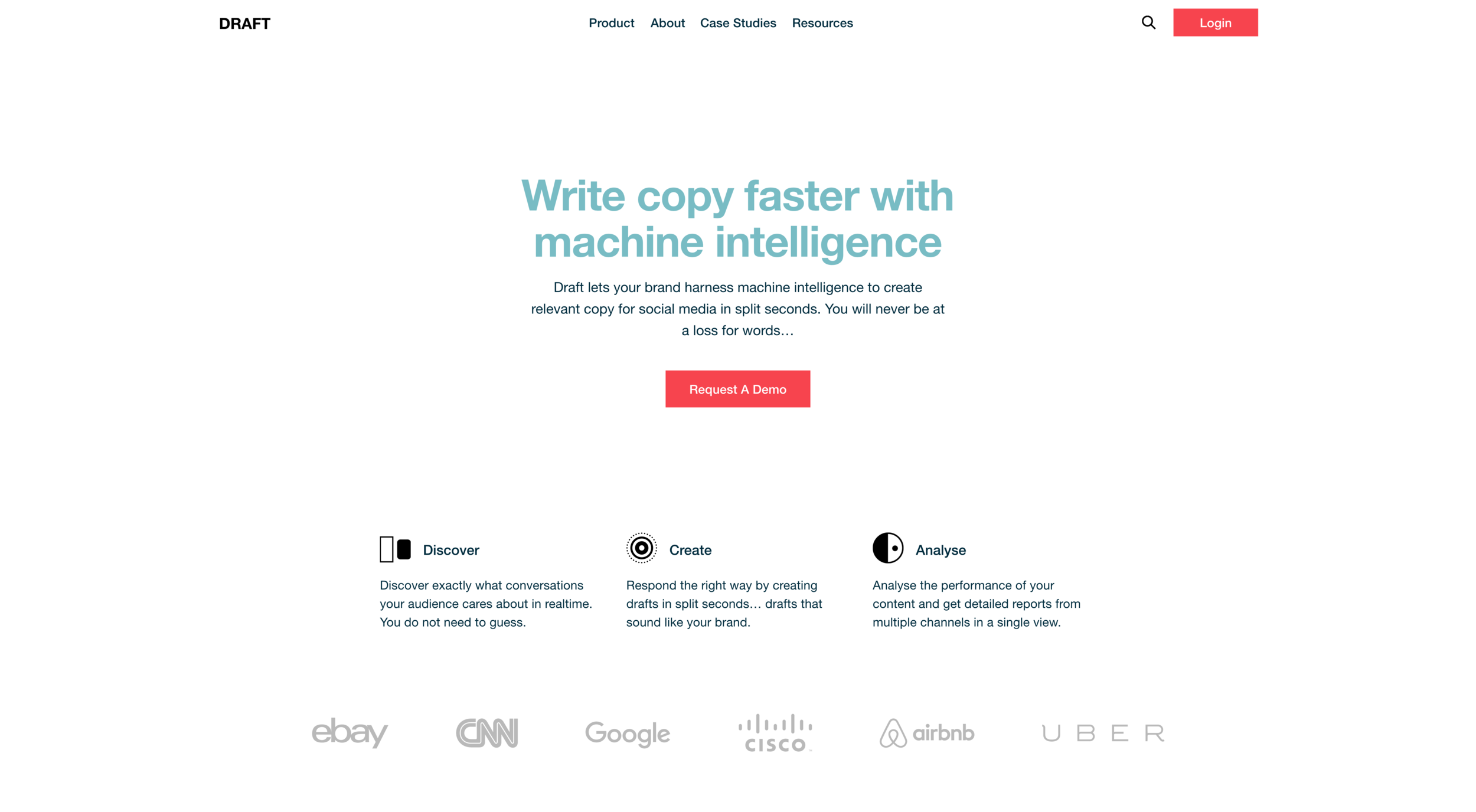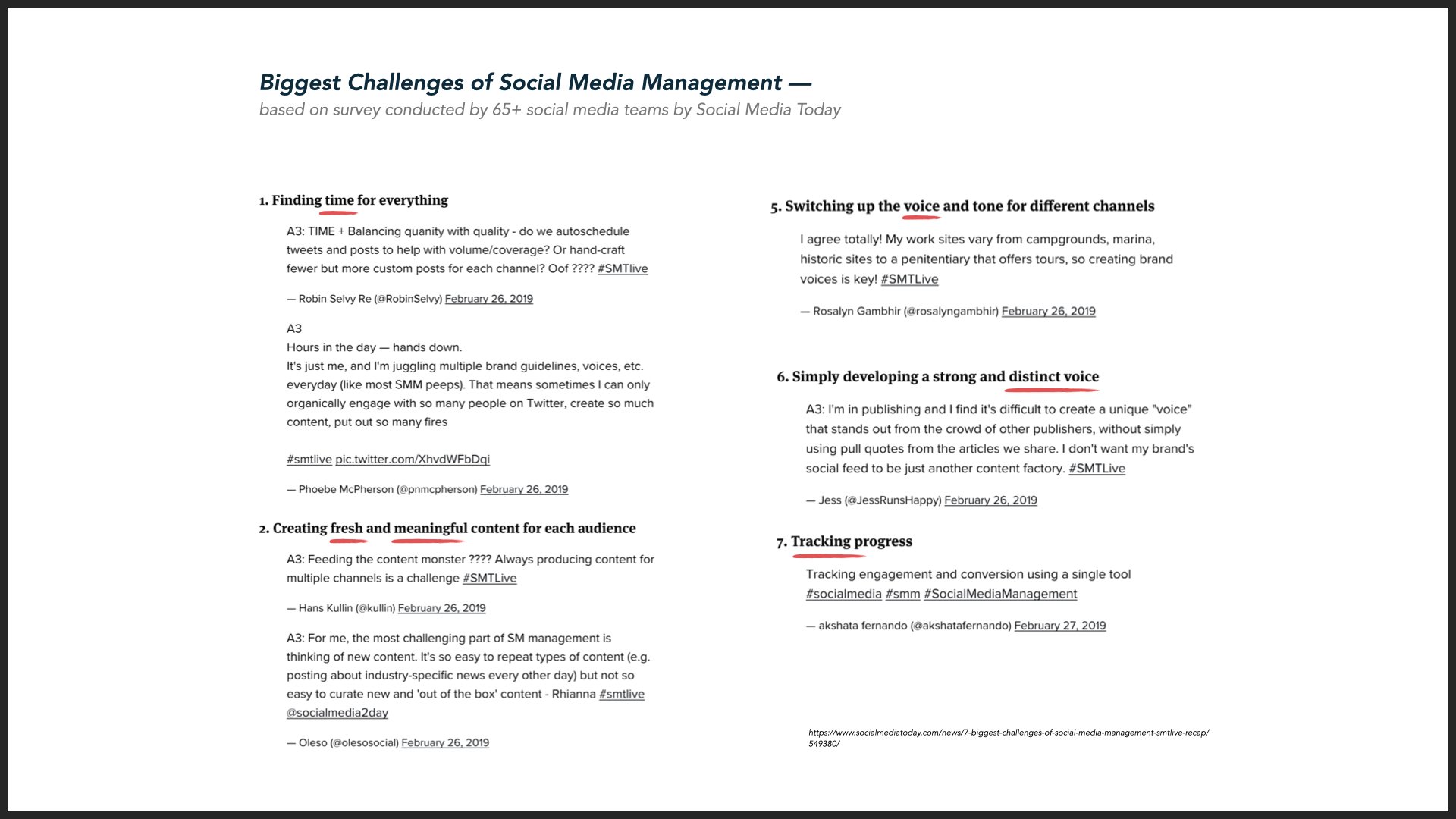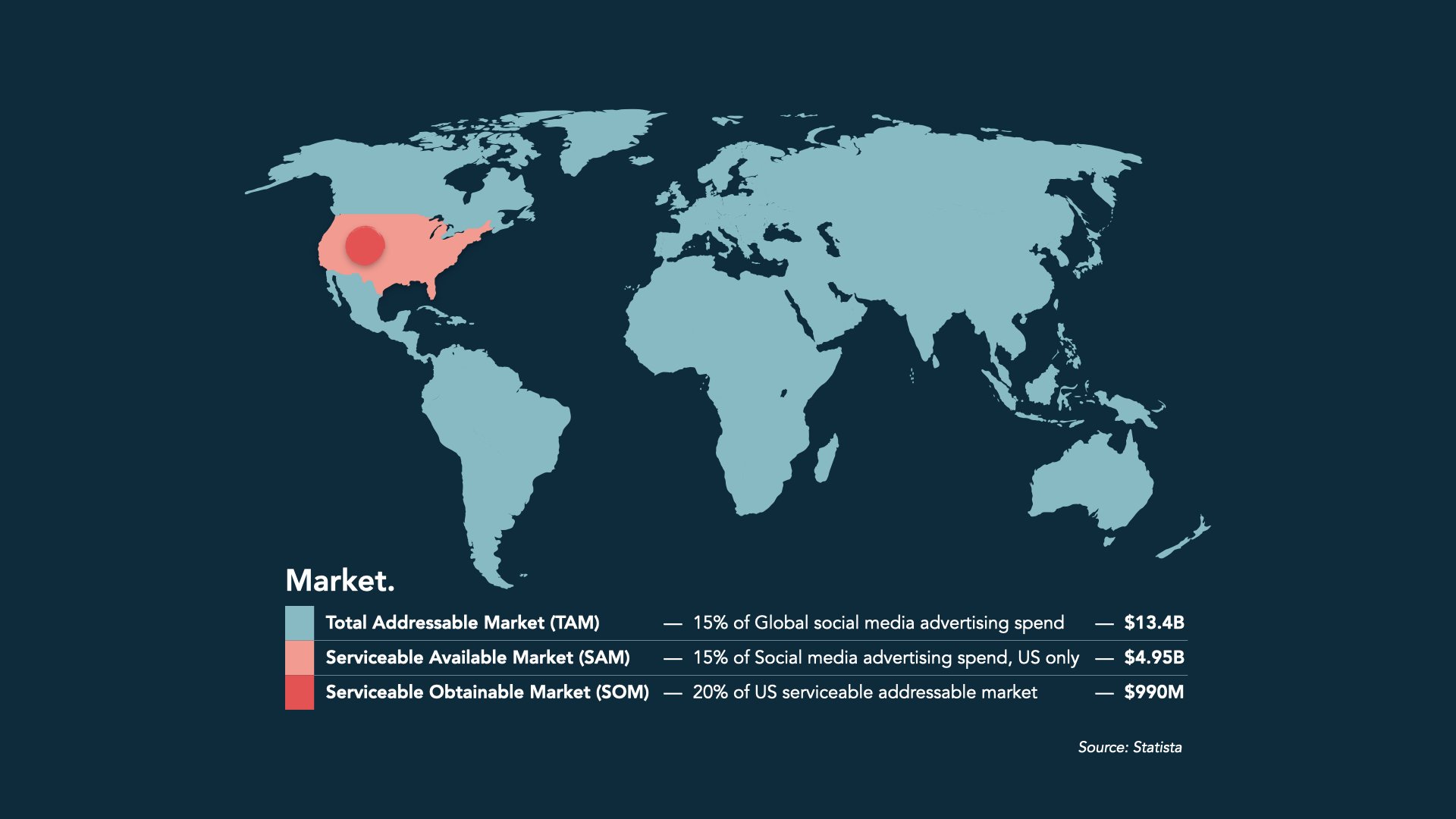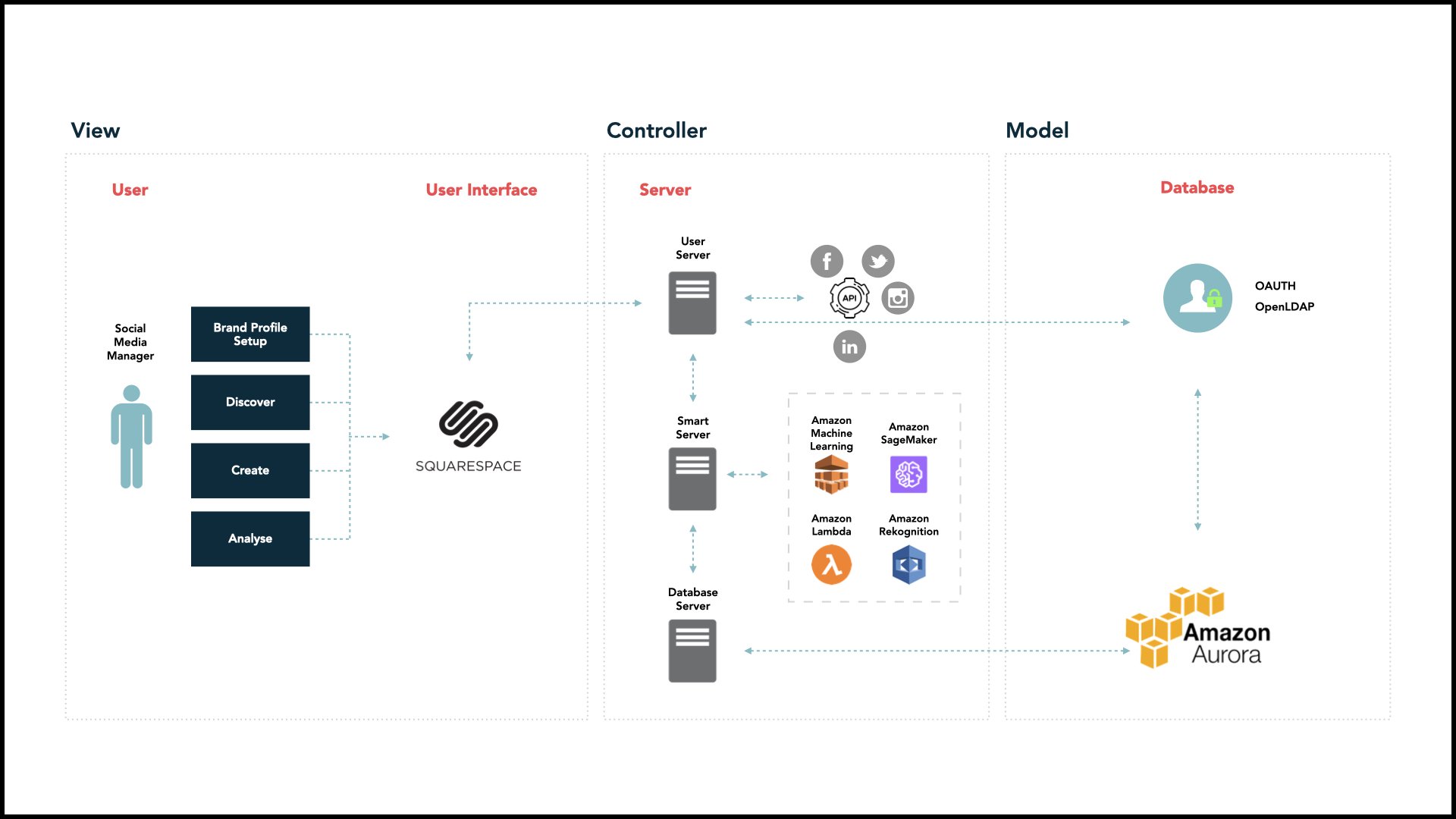Draft
New Product Development
Draft was developed in collaboration with Pranav, Lynda, and Maninee based on an idea I pitched on the first day of a Product Management class at Northwestern University’s McCormick School of Engineering in 2019.
ROLES
Team Lead
UI Design
Market Research
User Interviews
Copywriting
TOOLS
Balsamiq
Adobe XD
Keynote
Challenge
Social media managers spend 10-20 hours weekly creating content that requires copy. They have to do this because Brands must engage daily on social media to deepen the relationship with their audience. 3.2 billion social media users share tens of millions of content pieces on social media daily.
Opportunity
Artificial Intelligence and Machine Learning are increasingly being used to inform and manage content creation at scale. There is an opportunity to reduce the time social media managers and agencies spend researching and creating content by more than 50%. This time saving is especially valuable to social media managers at agencies who must manage multiple client accounts.
What is Draft?
For social media managers who spend 10-20 hours a week trying to create relevant and engaging content, Draft is the AI-powered content creation tool that provides human-sounding content drafts based on selected topics of interest. Unlike other content and social media management solutions, Draft creates multiple editable text options at the click of a button.
Discover
User can find trending and relevant conversations their audience is having. They can see how many people are currently engaged in what topic, what the overall sentiment is, and how long it has been a hot topic for.
Create
Create multiple drafts at the click of a button. Each draft can be edited, saved and added to a schedule. If the user is unsatisfied with all of the drafts another batch can be generated.
Analyse
Create multiple drafts at the click of a button. Each draft can be edited, saved and added to a schedule. If the user is unsatisfied with all of the drafts another batch can be generated.
How did Draft come to be?
I had insight into the challenges social media managers face because of my domain knowledge. The team and I worked with an initial hypothesis that social media managers find it challenging to keep up with and contribute to current conversations on social media, are likely to experience frustration because they spend too much time creating content from scratch, and find it challenging to constantly create engaging customer-centric content, and would need help with maintaining the brand’s social media voice.
We set out to test our assumptions by conducting secondary and primary research. We needed to clearly understand what social media managers aim to accomplish and what challenges they faced in meeting their goals. We took an approach that centred the potential user and their needs.
Market Research
This was based on a survey conducted by 65+ social media teams by Social Media Today
We also found that companies like Adobe already are developing products that use artificial intelligence to speed up the content creation process.
I started off leading the team to conduct secondary research on the internet to see if previous research relating to our hypothesis already existed, and to see if there was conversation around the topic. We found that time constraints, the need to always create fresh and meaningful content, maintaining the brand’s voice, and tracking progress to be key challenges social media managers faced.
Primary Persona
Our secondary personas, whom we called Butterflies, are responsible for other aspects of marketing or of the business, but manage social media because there isn’t a dedicated social media manager. The fact that they juggle multiple responsibilities make their social media strategies less effective because they cannot commit to the time that’s required to keep up with trends and to develop fresh content.
Based on our understanding of the challenge, we developed questionnaires and interviewed 15 social media managers at agencies and top companies like Amazon and Nike to gain a deeper understanding of the challenges they faced.
To vet our hypothesis, we kept our questions broad and allowed the interviewees share the challenges they faced without giving away what we were interested in learning about.
Our primary personas use social media to drive engagement, social relevance, customer service and ultimately sales for their brands. The Principals manage social media as a primary responsibility and are responsible for one or more social media platforms. They develop and implement social media strategy, measure engagement, and deal with brand-related issues followers may have.
Unmet Needs
After analysing the feedback from our user research and interviews, we uncovered the following pain-points and unmet needs:
Discovery (what is conversations are happening?)
In order to create relevant content, social media managers must first be aware what conversations are being had. Multiple listening tools that track conversations exist and are mostly siloed.
Creation (what do we say?)
Finding out what conversations are being had is the first step, but brands must then create content that is authentic and in character so as to engage and attract followers. Discovering conversations and creating relevant content is time-consuming.
Measurement (how did we perform?)
Brands need in-depth analytics regarding the performance of their content. This analysis can be comparative (against competing brands or industry engagement standards), or solely about the brands social engagement.
Affinity Map
This map was developed to give us a clear picture of the insights we uncovered from our research. We realized that our solution had to address all of these needs in order to provide value to a potential user.
We used user stories to break down the user’s needs, motivations, and expected outcomes in all scenarios relevant to their jobs, and as a basis for developing the feature-set.
User Stories
Customer Journey Mapping
I paid a lot of attention to understanding the user’s journey and spent time visualising it on my bedroom wall.
We held discovery sessions to further clarify the customers journey and to identify possible areas our solution could address.
Market Research / Competitor Analysis
I developed a matrix showing that our target social media managers worked at small or large brands with high social media dependence.
I created charts showing the growth trend in social media management spend by brands.
Used the competitor matrix to visualise existing solutions. These platforms provide tools for topic and trend discovery, content creation, scheduling, reputation management, influencer marketing and analytics. However, none of them offer an AI-powered content engine that generates content based on a users topics of interest. Draft fills this gap, instantly providing users with caption options. These captions are personalised and suited to the brands voice and persona. This is Draft’s key differentiator.
Partnerships in which the Draft content engine gets integrated with existing social media management platforms would provide access to a larger market.
I created a visual representation of competing solutions to show their areas of strength and where Draft fit on the continuum.
I created a visual representation of our Total, Available, and Obtainable markets, showing the US as our primary market.
Low Fidelity Mock-Ups
Based on the user stories, I created low-fidelity mock-ups with Balsamiq. The mock-ups show key features and layouts that became the basis for the prototype.
Our visual philosophy was for a clean, uncluttered, simple, intuitive, functional, and premium-looking interface. I created a mood board to capture the feel and colors we wanted the UI to have.
Mood Board
Information Architecture (MVC)
Model built by Maninee describing the product backend. Draft is a responsive website on designed for mobile phones, desktops and tablets so that users have a seamless user experience across multiple devices.
How did Draft evolve?
Over the course of 10 weeks, Draft evolved…
From single product to platform — Over the quarter, the vision for Draft evolved from one of a single product solution for social media to one of a platform with multiple use cases in email personalization, website copywriting, report writing, graphic design, presentation design, and video. While not all of these extensions will function based on a natural language processing engine, the long-term plan is that Draft becomes a content creation platform with extensive use cases and integrations with other platforms like SproutSocial, Adobe, and Canva.
From single-featured to multiple feature set — Draft is a software-as-a-service solution for small to medium brands and social media marketing agencies. We initially thought of it as a tool with a single main feature. However, based on our research on SaaS for business we realized that additional value-adding features needed to be included to make the solution more robust. This discovery helped us start to think of a whole-product solution with an additional set of features that were not initially considered.
Lessons
Draft was my first experience leading a product team and exploring Design Thinking as a methodology. Leading a product or design team requires empathy not only for the end-user, but for the team members. It requires an ability to make sure that each team member’s voice is heard, and to acknowledge everyone’s contributions.
To design is to be open to possibilities. It is detrimental to begin with pre-conceived solutions. A thorough understanding the user’s needs is a must.































